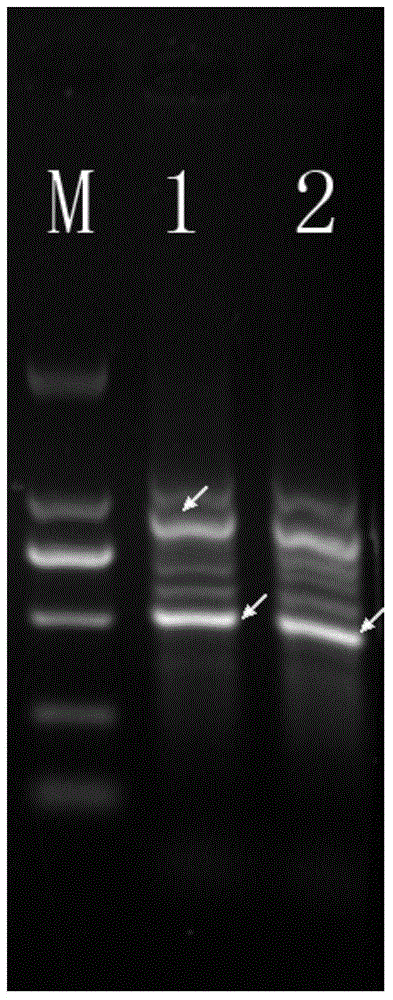Specific molecular marker DNA sequence of lactobacillus plantarum and application of specific molecular marker DNA sequence
A technology of Lactobacillus plantarum and molecular markers, which is applied in the field of specific molecular marker DNA sequences of Lactobacillus plantarum, can solve the problems of inconvenient molecular detection of Lactobacillus plantarum, and achieve the effects of low cost, short experiment time and simple operation
- Summary
- Abstract
- Description
- Claims
- Application Information
AI Technical Summary
Problems solved by technology
Method used
Image
Examples
Embodiment 1
[0042] The screening of the specificity PCR band of embodiment 1 different lactobacillus plantarum strains
[0043] (1) Template preparation
[0044] Each strain was activated, isolated and cultivated, and a single colony was selected from the obtained colonies, inoculated in 1ml of MRS medium, cultured anaerobically at 37°C for 24 hours, and centrifuged to obtain bacterial cells. The bacterial genome was extracted using a kit: TaKaRaminibest bacterial genomic DNA extraction kit ver.2.0 (Takara Biotechnology (Dalian) Co., Ltd.).
[0045] (2) PCR amplification
[0046] The system composition of PCR amplification is: 1 μ mol / L semi-random primer (its sequence is shown in SEQ ID NO.1), 0.5mmol / L dNTP, the Mg of 1.5mmol / L 2+ , 0.05U / μL Taq DNA polymerase, and 500ng (please express in concentration) genomic DNA template, the total volume is 50μL.
[0047] The PCR amplification program is: ①95°C, 5min; ②95°C, 30s; ③50°C, 30s; ④72°C, 2min;
[0048] (3) Acquisition of specific ban...
Embodiment 2
[0051] The acquisition of the specificity PCR band of embodiment 2 different lactobacillus plantarum strains
[0052] (1) Template preparation
[0053] Each strain was activated, isolated and cultivated, and a single colony was selected from the obtained colonies, inoculated in 1ml of MRS medium, cultured anaerobically at 37°C for 24 hours, and centrifuged to obtain bacterial cells. The bacterial genome was extracted using a kit: TaKaRaminibest bacterial genomic DNA extraction kit ver.2.0 (Takara Biotechnology (Dalian) Co., Ltd.).
[0054] (2) PCR amplification
[0055] The system composition of PCR amplification is: 2 μmol / L semi-random primer (its sequence is shown in SEQ ID NO.1), 1mmol / L dNTP, the Mg of 2.5mmol / L 2+ , 0.10U / μL Taq DNA polymerase, and 2ng / μL genomic DNA template in a total volume of 50 μL.
[0056] The PCR amplification program is: ① 95°C, 4min; ② 95°C, 20s; ③ 50°C, 20s; ④ 72°C, 60s;
[0057] (3) Acquisition of specific bands
[0058] The PCR product w...
Embodiment 3
[0060] The acquisition of the specific PCR band of embodiment 3 Lactobacillus plantarum strains
[0061] (1) Template preparation
[0062] The strains were activated, isolated and cultivated, and a single colony was selected from the obtained colonies, inoculated in 1ml of MRS medium, cultured anaerobically at 37°C for 24 hours, and centrifuged to obtain bacterial cells. The bacterial genome was extracted using a kit: TaKaRaminibest bacterial genomic DNA extraction kit ver.2.0 (Takara Biotechnology (Dalian) Co., Ltd.).
[0063] (2) PCR amplification
[0064] The system composition of PCR amplification is: 0.5 μ mol / L semi-random primer (its sequence is shown in SEQ ID NO.1), 0.2 mmol / L dNTP, the Mg of 1.0 mmol / L 2+ , 0.02U / μL Taq DNA polymerase, and 0.5ng / μL genomic DNA template in a total volume of 50 μL.
[0065] The PCR amplification program is: ① 96°C, 4min; ② 93°C, 40s; ③ 45°C, 40s; ④ 70°C, 120s;
[0066] (3) Acquisition of specific bands
[0067] The PCR product was...
PUM
 Login to View More
Login to View More Abstract
Description
Claims
Application Information
 Login to View More
Login to View More - Generate Ideas
- Intellectual Property
- Life Sciences
- Materials
- Tech Scout
- Unparalleled Data Quality
- Higher Quality Content
- 60% Fewer Hallucinations
Browse by: Latest US Patents, China's latest patents, Technical Efficacy Thesaurus, Application Domain, Technology Topic, Popular Technical Reports.
© 2025 PatSnap. All rights reserved.Legal|Privacy policy|Modern Slavery Act Transparency Statement|Sitemap|About US| Contact US: help@patsnap.com



